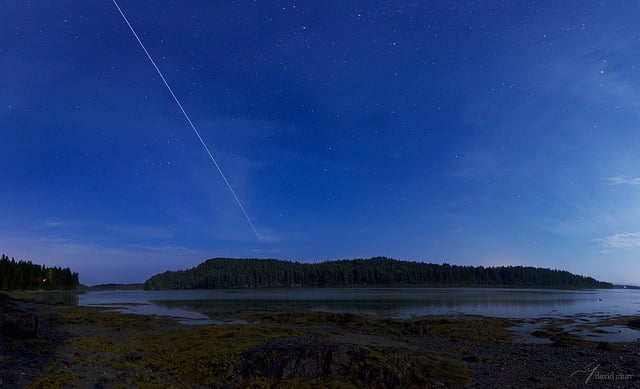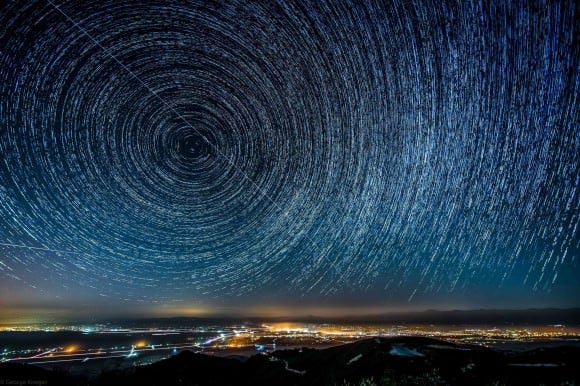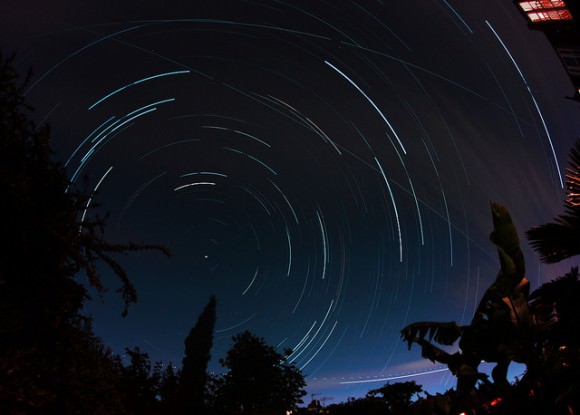How would you like to have one of your astrophotos sent up to the astronauts and cosmonauts on the International Space Station? Since arriving on the ISS back in May, astronaut
Reid Wiseman
has been posting beautiful images on social media of the International Space Station passing overhead, taken by people from all around the world.
There's a dedicated team of people working behind the scenes back on Earth to make sure Wiseman and his crewmates get to see as many images as possible. This is all part of the
SpotTheStation,
a project to get people to look up and see the ISS -- to increase the "visibility" off the space station, so to speak -- to make the general public more aware of the station and what benefits it brings to science. Of course, being able to see the space station fly overhead is always a fun experience!
The #SpotTheStation project is getting photographers more involved, too. We get several images a week posted on
our Flickr site
of space station passes (see the gorgeous one above by
David Murr
).
Take a look at some of the recent images
@Astro_Reid
has posted on Twitter:
Too much beauty! 30s exposure of #SpotTheStation at crater lake by @OregonTTpic.twitter.com/mu3yKTGco3 — Reid Wiseman (@astro_reid)
????????????????" @astro_reid: Another incredible #SpotTheStation from Kurt Harvey at Lee Vining Canyon in CA. Aug 3 pic.twitter.com/YffXGL3Oto " — ??? Satoshi Furukawa (@Astro_Satoshi)
Tweet #SpotTheStation if you see us fly over. Thanks Pete Glastonbury for sharing this great photo from Thursday. pic.twitter.com/DmUwYlCb0e — Reid Wiseman (@astro_reid)
If you see #ISS fly over, please tweet your town or location with #SpotTheStation - we are trying to map the world: http://t.co/WoyWEHfyCi — Reid Wiseman (@astro_reid)
As you can see, a map of #SpotTheStation Tweets is being created here.
How do you get your images sent up to the ISS? You can email your picture to
and include a description of your images of the ISS (location, date, times, maybe exposure information and techniques involved). Please also include your Twitter handle, Facebook or website information.
You can also just share your image through your social media outlets using #SpotTheStation hashtag.
How do you find out how to see the ISS? There are several different tools:
NASA's Spot the Station website:
Enter your Country, Region, City along with an email address or mobile phone number. Then give your preference for notifications in the evening, morning or both and that's it. About twelve hours before the station is due to fly overhead, you'll get a notification from NASA.
- Heaven's Above
-
A great website that will provide times and locations of where to look for the ISS and many more satellites that are flying over your location.
- ISS Tracker
-
A real-time location tracker.
- Satellite Flybys
-
A site that finds dates/times and the ccoordinates of a flyby at your location.
Fraser also put together a video (
and article
) about how to see the ISS:
You can find out more info this website, too.
We've also got a detailed guide on how to
View the International Space Station for Beginners
, and
How to Photograph the International Space Station
.
People are getting involved in this project, even if they've never taken a picture of the ISS previously. For example, photographer
George Krieger
who had never taken an image of the ISS before he heard of the #SpotTheStation project. He got right to it and on June 3 he captured two amazing ISS passes over Hollister, California. Take a look below:
[caption id="attachment_112552" align="aligncenter" width="580"]
The International Space Station makes two passes over Hollister California in this series of long exposure images. Credit and copyright: George Krieger. [/caption]
[caption id="attachment_112551" align="aligncenter" width="580"]
The International Space Station passes over Hollister California. Credit and copyright: George Krieger. [/caption]
Here are a few more pics from our Flickr pool:
[caption id="attachment_112550" align="aligncenter" width="580"]
Long exposure shots of bright passes by the International Space Station over the UK on June 11, 2014. Credit and copyright: Sarah and Simon Fisher. [/caption]
[caption id="attachment_112553" align="aligncenter" width="580"]
Composite image of the June 8, 2014 ISS pass, featuring Spica, the Moon and Mars. Credit and copyright: Dave Walker. [/caption]
[caption id="attachment_112556" align="aligncenter" width="580"]
175 x 45 second exposures taken between 23:37 on June 5, 2014 and 01:53 on the 6th capturing the 23:52 and 01:28 ISS passes over London. Credit and copyright: Roger Hutchinson.
[/caption]
Join in and maybe you can tell all your friend that YOUR image has been sent up to the International Space Station!
 Universe Today
Universe Today


